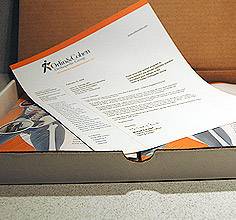Here’s a quick guide to the pros and cons of direct mail versus email, all of which should fuel the debate, aka the “Battle of the Mails.”
Direct Mail Pros
- Direct mail is taken seriously: When the mail arrives, it’s brought to a prominent location in the kitchen to be sorted, we get upset when it’s late, we break from whatever we’re doing to look through it and we get upset if there’s no mail (excluding bills, of course).
- Direct mail is more personal: It has our name on it; it belongs to us. We give it the attention it deserves, because it’s ‘’talking” to us.
- Regular mail is tangible: You can touch it, feel it, interact with it. Sure you can toss it, but it’s much more involved than simply hitting “delete” and poof, it’s history. DM has a “tail.” It can linger, sometimes for months so it’s available to be acted on at your leisure.
- You can tell a bigger story: Surround it with graphics, die cuts, pop-ups and create inactivity with it.
- Direct mail uses emotion: You can inspire and motivate. In email, people just want the facts and they move on . . . fast.
Direct Mail Cons
- Regular mail is much more expensive than email. Between printing, postage and overall quantities, DM can get quite pricey.
Email Pros
 It’s cheap (which is why spammers love it). Without a solid offer, response rates can be low, but with the negligible cost, it becomes a nonissue.
It’s cheap (which is why spammers love it). Without a solid offer, response rates can be low, but with the negligible cost, it becomes a nonissue.- Email is fast, both in execution and in delivery. Come up with a clever subject line, create some solid content and hit send. Your audience gets your email in seconds, so responses can start pouring in within minutes.
- Downloadable fulfillment pieces are instantly accessible. A white paper offer via snail mail that can take weeks, whereas a link in your email instantly downloads the white paper offer. This is a huge plus!
- Measuring the effectiveness of email campaigns is easy—and fast. We can track open rates and click-throughs almost immediately.
Email Cons
- Is your email just another light on the Christmas tree? With the avalanche of spam, is your email even noticed? With some spam protectors, is it even getting through? Check your reporting—that will be a good indicator as to whether they are being read, or even opened in the first place.
- Email messages need to be kept short. To tell them more, bring them to a landing page that can go into greater detail.
- Blacklisting: Selecting the right launch platform so your server isn’t blacklisted for spamming is essential. Make sure your launcher is “Can-Spam Compliant” and you are utilizing opt-in lists.
- Good email lists are very difficult to find. No matter what has been promised, chances are a good number won’t find their targets.
- Email limits your creativity. Let’s face it: an HTML email is boring to look at, so your subject line and “short” content better be spellbinding!
So which “mail” dominates in today’s marketplace? The simple answer is… neither! If you thought there was one winner, a revered panacea, either electronic or traditional… there are just too many variables!
What do you think? What’s worked for you and what went down in flames? Jump in—I don’t want to hear “It’s in the mail!”










